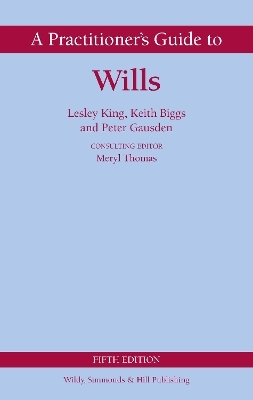
A Practitioner's Guide to Wills
Wildy, Simmonds and Hill Publishing (Verlag)
978-0-85490-296-5 (ISBN)
• What are the requirements for the virtual witnessing of wills executed during the Covid-19 pandemic?
• What can be done to help prevent a successful challenge to a will if the testator’s capacity or intention might be an issue?
•To what extent can the terms of a will give rise to a need to register a trust with HMRC?
• What are the pitfalls if creating a will trust where it is hoped to claim the inheritance tax residential nil rate allowance?
• Do nil rate band discretionary trusts still have a purpose in estate planning?
• How does the court now deal with disputes over the interpretation of wills in light of Marley v Rawlings and family provision claims after Ilott v Blue Cross?
The book also contains an extensive range of specimen clauses and model wills are set out in a separate appendix. All precedent material in the book is included on the accompanying CD-ROM.
Lesley King is a professor at the University of Law and writes and lectures extensively on wills, taxation and related matters. Her books include A Modern Approach to Lifetime Tax Planning for Private Clients; Varying the Disposition of an Estate after Death; and Wills: A Practical Guide (WSH). Peter Gausden is a solicitor and was formerly a principal lecturer at the College (now University) of Law. He now acts as a private client consultant at Rowlinsons and is a current contributor to Tolley’s Administration of Estates Keith Biggs is a former District Probate Registrar who now acts as a probate consultant. He is co-author of A Practitioner’s Guide to Probate and the Administration of Estates (WSH). Meryl Thomas has worked in practice and is currently Professor of Law at the Institute of Law in Jersey. She has worked at several universities and institutions around the world
Preface
Table of Precedents
Table of Cases
Table of Statutes
Table of Statutory Instruments
Table of Conventions
1INTRODUCTION
2THE NATURE OF A WILL
2.1Definition
2.2A will distinguished from other concepts
2.3Contracts to make a will
2.4Joint and mutual wills
2.5Property which can validly be disposed of by will
3TESTAMENTARY CAPACITY
3.1Changes in capacity
3.2Minors
3.3Persons who lack capacity
3.4Intention
3.5Knowledge and approval
3.6Mistake
3.7Force, fear, fraud or undue influence
4FORMAL REQUIREMENTS FOR THE CREATION OF A WILL
4.1General
4.2Writing
4.3Signature
4.4Attestation
4.5Capacity of witnesses
4.6Privileged wills
4.7Incorporation of unattested documents
5BENEFICIARIES
5.1General
5.2Gift to a beneficiary who predeceases the testator
5.3Unlawful killing
5.4Gifts for the upkeep and maintenance of graves
5.5Gifts for animals
5.6Gifts to societies and clubs
5.7Gifts to charities
6BENEFICIARIES IDENTIFIED BY DESCRIPTION OR RELATIONSHIP
6.1Introduction
6.2Relationship by blood and affinity
6.3Gender-specific drafting
6.4Illegitimacy and adoption
6.5Children
6.6Descendants
6.7Step-children
6.8Issue
6.9Survivors
6.10Spouses and civil partners
6.11Next of kin
6.12Heir
6.13Holders of an office
6.14Precatory words
6.15Secret trusts
7REVOCATION AND ALTERATION
7.1Revocation
7.2Divorce and revocation
7.3Revocation by a privileged testator
7.4Conditional revocation
7.5Alteration
8CODICILS, REVIVAL AND REPUBLICATION
8.1Codicils
8.2Revival
8.3Republication or confirmation
9EXECUTORS AND TRUSTEES
9.1Appointment of executors
9.2Who can be an executor?
9.3Renunciation
9.4Appointment of trustees
9.5Guardians
10THE DISPOSAL OF THE BODY
10.1Directions as to disposal
10.2Anatomical research and organ transplantation
11FOREIGN PROPERTY OR DOMICILE
11.1General
11.2The concept of domicile
11.3Movables
11.4Immovables
11.5Powers of appointment exercised by will
11.6EU Regulation 650/2012
12LEGACIES
12.1Specific Legacies
12.2General Legacies
12.3Demonstrative legacies
12.4Gifts to a debtor
12.5Gifts to an executor
12.6Gifts to employees
12.7Gifts of undivided shares of personalty
13GIFTS OF BUSINESSES
13.1Business property relief
13.2Succession planning
14GIFTS OF LAND
14.1General
14.2Gifts to minors
14.3Directions as to inheritance tax
14.4Impact of the residence nil rate band
14.5Gifts of undivided shares and clauses dealing with joint property
14.6Right to occupy a personal residence
14.7Gifts of testamentary options
14.8Gifts of leaseholds
15CONDITIONS ATTACHED TO GIFTS
15.1Conditions precedent and subsequent
15.2General
15.3Effect of invalidity
15.4Determinable Interests
16PILOT TRUSTS
16.1Background
16.2Traditional pilot trust planning before the 2015 changes
16.3The new rules introduced by the Finance (No 2) Act 2015
16.4Additional points on the new rules
16.5Is there any place for future pilot trusts planning?
16.6Non-related settlements
17GIFTS OF RESIDUE
17.1General
17.2The necessity for a trust
17.3Trust for sale or power to sell
17.4Different persons as executors and trustees
17.5Trusts of fractional shares of residue
17.6Providing for spouses and civil partners
17.7Burden of inheritance tax
17.8Survivorship clauses
17.9Substitutional gifts
18POWERS AND DISCRETIONARY TRUSTS
18.1Nature and classification of powers
18.2Wills Act 1837, section 27
18.3Perpetuities and Accumulations Act 2009
18.4Delegation of powers
18.5Consent to exercise power
18.6Release of powers
18.7Fraudulent appointments
18.8Discretionary trusts
18.9Nil rate band discretionary trusts
18.10Trusts for the disabled
18.11 Protective trusts
19INCOME AND INTEREST
19.1Immediate specific gifts and devises
19.2Contingent or deferred specific gifts
19.3General and demonstrative gifts
19.4Residuary gifts
20ABATEMENT, ADEMPTION, ELECTION, SATISFACTION AND CONVERSION
20.1Abatement
20.2Refunds
20.3Ademption
20.4Options to purchase and ademption
20.5Republication and ademption
20.6Election
20.7Satisfaction
20.8Conversion
21TESTAMENTARY OPTIONS TO PURCHASE
21.1Introduction
21.2Terms
22ADMINISTRATIVE PROVISIONS
22.1Introduction
22.2Appropriation of assets
22.3Power to act though personally interested and to purchase trust property (‘self-dealing’)
22.4Retention of directors’ remuneration
22.5Power to act by majority
22.6Power to employ agents
22.7Appointment of new trustees
22.8Power to act on counsel’s opinion
22.9Indemnity clauses
22.10Charging clauses
22.11Power to invest
22.12‘Anti-Bartlett’ clauses
22.13Power to acquire land
22.14Powers to manage land
22.15Insurance
22.16Debts
22.17Power to carry on a business
22.18Power to borrow
22.19Powers in relation to particular beneficiaries
22.20Power to advance capital
23PERPETUITIES AND ACCUMULATION
23.1The general perpetuity rule
23.2The rule against vesting outside the perpetuity period
23.3The rule against perpetual trusts
23.4The rule against accumulations
24CONSTRUCTION
24.1General principles
24.2The modern approach to construction
24.3Presumptions
24.4Admissibility of extrinsic evidence
24.5Rectification
24.6Date from which a will ‘speaks’
24.7The falsa demonstratio doctrine
24.8Construing the same words in different parts of the same will
24.9Meaning of particular words of description
24.10Per capita and per stirpes distribution
24.11Children born as a result of fertilisation techniques
24.12Surrogacy arrangements
24.13Class gifts
24.14Absolute interests made subject to restrictions
24.15Gifts to legatees and their children
24.16Gifts to legatees and their issue
24.17Gifts to benefit legatees
24.18Gifts over
24.19Contingencies relating to gifts over on death
24.20Divesting
24.21Failure of issue
25FAILURE OF GIFTS AND INTESTACY
25.1Uncertainty
25.2Disclaimer
25.3Forfeiture on contesting a will
25.4The effect of failure
25.5Acceleration of a subsequent interest
25.6Intestacy
25.7Accruer clauses
26FAMILY PROVISION
26.1Introduction
26.2Time limit for applications
26.3Those who can apply
26.4Reasonable financial provision
26.5The guidelines
26.6Property available for financial provision
26.7Orders which the court may make
26.8Interim payments
26.9Anti-avoidance
26.10Tax implications
26.11Minimising the chances of a successful claim
27INHERITANCE TAX
27.1The charge to tax
27.2Transfers of value
27.3Value transferred
27.4Transfers which are not transfers of value
27.5Chargeable transfers
27.6Excluded property
27.7Exemptions and reliefs
27.8The transferable nil rate band
27.9The residence nil rate band
27.10Reservation of benefit
27.11The reduced rate for charitable giving
27.12General tax planning
27.13Post-death variations
28CAPITAL GAINS TAX
28.1Introduction
28.2Rates of tax
28.3Disposal of assets
28.4Effect of death
28.5Exemptions and reliefs
28.6Accelerated payment of tax
28.7Rearranging succession provisions after death
28.8Basic tax planning
29SETTLEMENTS
29.1Liability to inheritance tax
29.2Liability to capital gains tax
29.3Inheritance Tax Act 1984, section 144: appointments from trusts within 2 years of death
29.4The need to register settlements
30TAX-EFFICIENT WILL PLANNING
30.1Introduction
30.2Estate planning options
30.3Problems with using the residence nil rate band
APPENDICES
A1COMPLETE WILLS AND MISCELLANEOUS PRECEDENTS
A1AStandard will: full form (long)
A1BMutual wills
A1CWill disposing of a business
A1DWill of widow(er) exercising power of appointment given by will of pre-deceased spouse or civil partner
A1EWill giving nil rate band legacy to discretionary trust
A1FSimple will giving all property to another of full age absolutely
A1GCodicil made on separation from spouse or civil partner prior to divorce or annulment
A1HWill providing for discretionary trust of income during perpetuity period with division of capital at the end of period between surviving beneficiaries
A1ILetter of wishes to trustees
A1JDeed of variation to sever beneficial joint tenancy and create nil rate band legacy
A1KDeed of variation of a will
A2NIL RATE BAND DISCRETIONARY TRUSTS WITH DEBT/CHARGE PROVISIONS
A2AExplanatory note
A2BAdditional clauses for a will containing a nil rate band discretionary trust which is to include debt/ charge provisions
A2CDebt scheme: draft letter from the executors to the trustees of the legacy fund (when a charge is being imposed by the executors)
A2DDebt scheme: securing the debt
A3TEMPORARY CHANGES TO WILLS ACT 1837, SECTION 9 TO ALLOW REMOTE WITNESSING
A3.1The position in April 2020 at the beginning of the COVID-19 lockdown
A3.2The amending legislation
A3.3The procedure for remote witnessing
A3.4Possible attestation clause where both witnesses are witnessing remotely
A3.5Problems
Index
| Erscheinungsdatum | 12.01.2023 |
|---|---|
| Reihe/Serie | Wildy Practitioner Guide Series |
| Mitarbeit |
Berater: Meryl Thomas |
| Verlagsort | London |
| Sprache | englisch |
| Maße | 152 x 229 mm |
| Gewicht | 1080 g |
| Themenwelt | Recht / Steuern ► EU / Internationales Recht |
| Recht / Steuern ► Privatrecht / Bürgerliches Recht ► Besonderes Schuldrecht | |
| ISBN-10 | 0-85490-296-1 / 0854902961 |
| ISBN-13 | 978-0-85490-296-5 / 9780854902965 |
| Zustand | Neuware |
| Haben Sie eine Frage zum Produkt? |
aus dem Bereich


